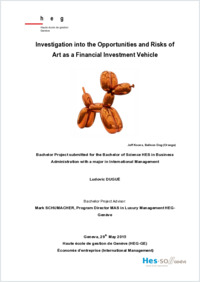Investigation into the opportunities and risks of art as a financial investment vehicle
SONAR|HES-SO
- Dugué, Ludovic
- Schumacher, Mark (Degree supervisor)
-
2015
67 p.
Mémoire de bachelor: Haute école de gestion de Genève, 2015
English
The world of art has experienced a strong and rapid growth since the “Art Bubble” of the 1980s. This growth has been translated by the democratization of various tools to invest in art and the appeal to generate more revenues thanks to alternative investments. Consequently the art market became more volatile, leading to numerous speculative investments especially between the years 2004 and 2007. Moreover, because the art market is known to be highly opaque and illiquid, one would argue that investing in art could be risky. Therefore, because of the present opacity on the art market, the purpose of this Bachelor thesis is to present art as a particular object of investment and to enlighten the different methods of investing in art. Assessing the different rates of returns by either direct or indirect investment as well as appraising the overall risks that investors could be confronted to, this paper will guide us to final recommendations that are devoted to the mitigation of the latters. Hence, this Bachelor thesis shall be read and used as a practical guide for anyone willing to invest in art. It is important to mention that art has a low correlation with the traditional stock market and has been recently used to diversify one’s portfolio. Thus, the question of determining art as an asset class has been raised many times. Indeed, some actors are still in disagreement and the decision to define art as an asset class still belongs to each of us. As said previously, art investment encompasses two distinct methods, the direct and the indirect one. The direct investment provides less liquidity compared to the indirect investment. The reasons of the investment vary depending on the real purpose of the individual. The direct investment would be, in general, dedicated to personal and aesthetic reasons, whereas the indirect investment through an art fund is evidently chosen for financial purpose thanks to high rates of returns. Indeed, rates of returns for indirect investment can reach more than 25% in a very short-time period. Furthermore, contemporary art generates the greatest rate of return with an average of 9% compared to Old Masters, for example, which reach only 5.52%. Finally, the risks assessed for the last part are not only related to the works of art, the different parties i.e. buyers and sellers, and the environment but also to financial risks, which are related to the time period and the amount spent on artworks. Final recommendations defined at the chapter four are of interest for prospective passionate individuals or potential private investors. Eventually, researches were mainly done in Switzerland but also in Paris, France with the help of an independent art dealer in order to have a broader view of the current art market.
- Language
-
- English
- Classification
- Economics
- Notes
-
- Haute école de gestion Genève
- Economie d'entreprise
- hesso:hegge
- License
- License undefined
- Identifiers
-
- RERO DOC 258571
- RERO R008353142
- Persistent URL
- https://sonar.ch/global/documents/314755
Statistics
Document views: 94
File downloads:
- TDEE_Duge_Ludovic.pdf: 193
